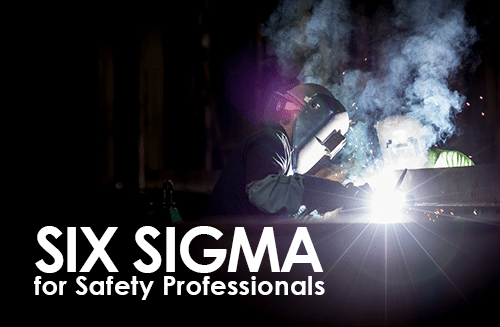Six Sigma is a set of tools and processes designed to reduce defects and improve processes. Introduced by Bill Smith from Motorola in 1986, the Six Sigma system has since been adopted by large publicly traded companies like GE, Amazon, Bank of America, 3M, and more.
A significant portion of Six Sigma practices are designed around reducing defects. Defects in products create costs for companies, so reducing defects can improve the financial performance of manufacturing companies. Six Sigma practices can also reduce production and delivery time by eliminating wasteful actions and focusing on the important elements of a process.
It’s clear that Six Sigma can be used to increase profits, reduce process time, reduce costs, and increase customer satisfaction. But can these systems be used to improve facility safety? How can safety professionals apply Six Sigma processes to keep people safe? If we think about workplace accidents as type of defect and work to reduce them, we can improve our businesses and make people safer.
Six Sigma relies on a process with 5 phases called DMAIC (Define, Measure, Analyze, Improve, and Control):

- Define the system, the voice of the customer and their requirements, and the project goals, specifically.
- Measure key aspects of the current process and collect relevant data; calculate the ‘as-is’ Process Capability.
- Analyze the data to investigate and verify cause-and-effect relationships. Determine what the relationships are, and attempt to ensure that all factors have been considered. Seek out root cause of the defect under investigation.
- Improve or optimize the current process based upon data analysis using techniques such as design of experiments, poka yoke or mistake proofing, and standard work to create a new, future state process. Set up pilot runs to establish process capability.
- Control the future state process to ensure that any deviations from the target are corrected before they result in defects. Implement control systems such as statistical process control, production boards, visual workplaces, and continuously monitor the process. This process is repeated until the desired quality level is obtained.
Let’s take these Six Sigma processes and apply them to safety.
The definition of a system from a safety perspective is simple. You must identify what work is being done and what the desired outcome is. For example, a manufacturing process that aims to add a bevel to a piece of wood ends with an outcome of a beveled piece of wood. The goal is to produce that item as quickly and safely as possible.
The second step in applying Six Sigma processes to safety is measurement. Six Sigma relies on data to improve processes, and collecting the correct data is critical to improving outcomes. At Haws, we collect information about safety incidents in several different ways to ensure we have a complete picture. Our detailed data about safety incidents, near misses, and other metrics are tracked over time. This data can be self-reported by workers in anonymous form collection bins we placed throughout our facility, as well as reported directly to the workers’ supervisor. A standardized data collection form that requires quantitative safety data for submission makes the data easy to spreadsheet, track, and report on. Random safety inspections by our safety team led by Melanie Mayer give us a closer look at processes in the building that require further improvement.
It’s important to collect and monitor safety data over long periods of time. Single data points about safety incidents are important, but do not give you deep insights about potential areas for improvement. In processing data you may find that patterns start to emerge. Perhaps workers are more likely to be injured or have a safety event with a particular tool or piece of equipment. You will only get this insight from long-term data capture. The long-term tracking and processing of safety data will enable a deeper understanding of areas for safety improvement.
Data about safety events, injuries, near misses, and hazards must be processed in a systematic way. A monthly processing of newly collected safety data can provide new insights into potentially unsafe behaviors and equipment. Time-series analysis of data can demonstrate issues on certain days of the week or month caused by external factors, or show that certain equipment must be replaced after a given period of time in order to prevent accidents. For example, you might find while processing safety data that includes the purchase date of equipment that certain hearing protection stops being effective after a period of time due to material degradation, prompting workers to injure their hearing. This kind of finding would never be possible without a complete collection of data that includes the equipment type and purchase date. Be creative and start looking at data that is not necessarily related to the equipment or personnel. You might come to surprising conclusions about how to keep your team safe!
After defining a process, measuring the important attributes, and analyzing the data you’ve collected, it’s time to apply your knowledge. Every safety manager knows that small changes can make a big difference in the health and safety of your team. Start by making small tweaks to your process, whether it’s improving or replacing equipment, changing a process, or giving training.
In order to have conclusive results about the success of your safety improvements, it’s important to isolate the changes so that you can compare your test to your control data. That’s a great time to bring up the fifth step of the DMAIC process: Control. It’s important while making these changes that you document the steps you took and track the same data you were before the changes. This is because making several changes simultaneously can confound the results and make it unclear which of your changes improved your process.
Six Sigma is a valuable system for safety professionals because it provides a solid conceptual framework for making safety changes in a data-driven way. Following the Six Sigma system generates large quantities of useful safety data that will benefit your company and team members for years to come.




